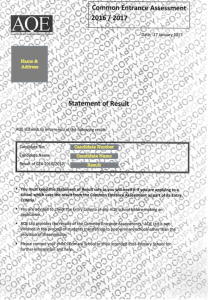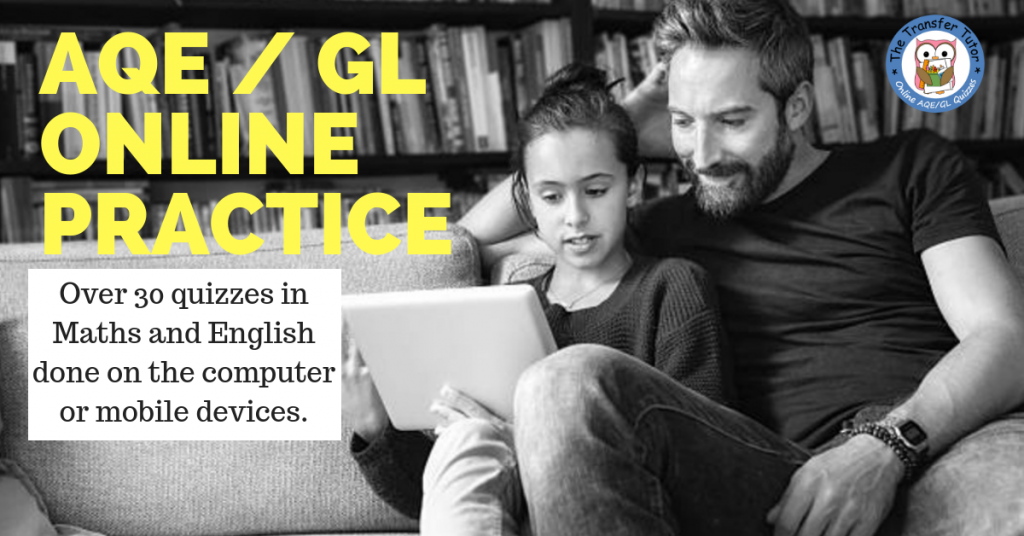The Marking Process

Each assessment is marked in the week following the test, in two test centres in Northern Ireland. In total, there are sixty markers in each test centre and they work in groups of three, along with a manager and two deputy-managers. Each paper is marked and totalled three times. Then, just to be completely sure and for Quality Control, 20% of the papers are marked again and a further 20% are added again.
Best Two Out Of Three

One of the best features of the AQE test, in my opinion, is that they calculate the individual scores for each of your child’s three tests and then take the average of the top two scores to work out the final AQE score awarded. This means that kids can afford to have an ‘off-day’ and still do brilliantly in the AQE test.
The Statement Of Result

The ‘Statement Of Result’ document is what you’ll receive in the post and it clearly indicates the overall score achieved. Do take note that you need to look after this very carefully because this will be attached to your post-primary transfer form and a photocopy will not suffice. The school will take the original document (usually during the transfer interview) so if you want a memento or keepsake, you’ll should make your own copy (even a photo on your phone) in advance.
Who Gets Informed Of Your Result?

As well as the Statement of Result letter that will arrive at your address (addressed to the parent), the child’s Primary School and the AQE Grammar School Centre will also receive notification of the child’s result (if you’ve given persmission).
Requesting A Remark

AQE are not specific on a deadline for a remark request, but the process to request a remark will be sent out with your AQE result and there will be a small charge. AQE also advise that although there have been no changes to marks over the last six years (they claim because of their robust marking procedures), and they warn that the mark, if changed, can go down as well as up and the remark score will be the final one.
AQE Standardised Scoring Explained
Terminology

So before we really start, let’s define some of the basic terms:
- Raw Score – the actual score that the child achieved in a test and this.
- Standardised Score – calculated by comparing the actual score to the average for that test. A standardised score of 100 represents the mean.
- Mean – this is the average of the raw scores for that test.
What’s The Point Of Standardised Scores?

There are benefits of standardised scoring and statistically it’s used to translate a raw score into a standardised score and this will offer a year-on-year consistent and comparable mark. Standardised scoring is not a new concept and is used in GCSEs and A Levels, so worth getting your head around it now (if you want to).
So, let me try to explain a little further with an example.
Below are the results of two sisters who did the AQE test in different years:
- In 2012, Jane achieved a raw score of 70% and when she opened her Statement of Results she achieved a standardised score of 102.
- In 2015, Simone achieve a raw score of 75% and when she opened her Statement of Results she achieved a standardised score of 100.
In this example, although Simone had technically done better in the test than Jane (75% compared to 70%), when the test results were standardised it became clear that Jane did better than Simone with a score of 102 compared to 100. This is fundamentally because the average scores in the tests would have been higher in Simone’s test which meant that Simone’s score of 100 was exactly the mean (average). However, in Jane’s case, she did better than the average as she scored above 100.
The Range Of Scores

Each AQE test is marked out of 64, so the raw score achieved can be anywhere between 0 – 64.
The range of the standardised scores will be between 55 – 145, however in previous years the highest AQE score achieved is usually around 128, so 145 is more of a hypothetical maximum which would require the child to achieve 100% in both tests but would also require a very low average (so not realistic).
Age Impact On Standardised Scores

AQE explain that each pupil’s age is translated into the real number of months for each test and then the child is put into the group with all the other kids who have the same closest months.
For example, Sarah who is aged 10 years, 7 months and 10 days on the day of the first paper on Saturday 14th November will be considered to be 127.3 months on the day of the first paper and put in with all the people of 127 months. AQE also point out that, in this same example, Sarah will be 10 years, 7 months and 24 days on the second paper and when this is converted into months, it works out as 127.8 so for the second assessment, Sarah will be in the group of 128 months people.
Then for each group the mean (average) will be calculated and your child’s score will be compared to the mean to work out their standardised score.
Here are the key points to note:
- If the child gets the same raw score as the average raw score of the group, then they will score 100 (standardised score).
- If the child scores more than the average, they will achieve a score greater than 100.
- If the child scores less than the average, they will achieve a score less than 100.
It is not true that a child is allocated extra marks for being younger.
Working Out The Final Score

For a child who completes three papers, three separate standardised scores will be worked out and as mentioned earlier, the average of the best two scores is calculated for the child and this becomes their ultimate AQE score.
For a child who completed only two papers, then the average of these two scores will give the child’s ultimate AQE score.
If a pupil only did one test, then they will be send out the raw score for that test.
Getting Your Raw Score
Although you will only be sent the standardised score, it is possible to obtain your raw scores from the AQE office. To do this, you simply email them at info@aqe.org.uk or by telephone on 02890 224002.
More about The Transfer Tutor (Multi-Award Winning App)

The Transfer Tutor’s Online Quizzes provide a fun and interactive way to learn and practise Maths and English questions which are directly aligned to both the AQE and GL specifications.
All quizzes are broken down into manageable topics and there are many, great features including (but not limited to):
- Mobile friendly and works on any internet device.
- In many questions, there will be a ‘Hint’ option that offers the child details on the ‘rule’ or aids them to complete it correctly which helps their future application and confidence.
- The Leaderboard at the end makes the child feel like they’re playing a game and having friendly competition.
- Good use of colour and graphics which makes it exciting.
- Parents receives a progress email at the end to let them know how their child did.
Simply choose the licence you need depending on the length of time you need access, click on the blue box, pay and then you’ll be off within minutes.
For any further questions, please contact me or check out the Frequently Asked Questions page.
Try It Out:

To give you a feel for the quizzes, why not try out the quick fire free quiz by clicking on the button below (no need to register or pay, so don’t worry). This will hopefully let you see how the questions work – or more importantly, let you see if this is something that would inspire and encourage your child to learn.
Social Media Links – Keeping Up To Date

Follow or like The Transfer Tutor on your social media channel of choice and ensure you never miss a beat with the whole transfer process, handy tips, advice, special offers and competitions.
Click below for your preferred channel or search for @TransferTutorHQ wherever you are.
Free Facebook Group

You may have read in the reviews about people referring to the Facebook Support Group and this is certainly a great place to keep informed, ask questions, get support and keep up-to-date with anything happening in the transfer space.
It’s free to join but please ensure you have a genuine Facebook profile picture (ghost pictures are not approved as not deemed authentic) and then simply click here and answer the simple questions -> Join Facebook Group.


